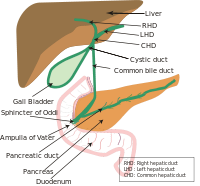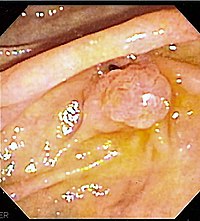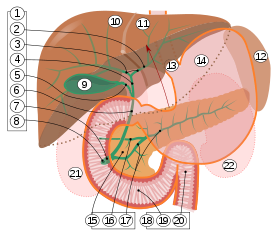Ampulla of Vater
| Ampulla of Vater | |
|---|---|
 A diagram of the biliary system. Note that the ampulla of Vater is behind the major duodenal papilla. | |
 The major duodenal papilla, seen on duodenoscopy at the time of ERCP. This is the protrusion of the ampulla of Vater into the duodenum. | |
| Details | |
| Identifiers | |
| Latin | Ampulla hepatopancreatica, ampulla Vaterii |
| MeSH | D014670 |
| TA98 | A05.8.02.017 |
| TA2 | 3111 |
| FMA | 15076 |
| Anatomical terminology | |
The ampulla of Vater, also known as the hepatopancreatic ampulla or the hepatopancreatic duct, is formed by the union of the pancreatic duct and the common bile duct. The ampulla is specifically located at the major duodenal papilla.
The ampulla of Vater is an important landmark halfway along the second part of the duodenum that marks the anatomical transition from foregut to midgut, and hence the point where the celiac trunk stops supplying the gut and the superior mesenteric artery takes over.
Structure

2. Intrahepatic bile ducts
3. Left and right hepatic ducts
4. Common hepatic duct
5. Cystic duct
6. Common bile duct
7. Ampulla of Vater
8. Major duodenal papilla
9. Gallbladder
10–11. Right and left lobes of liver
12. Spleen
13. Esophagus
14. Stomach
15. Pancreas:
16. Accessory pancreatic duct
17. Pancreatic duct
18. Small intestine:
19. Duodenum
20. Jejunum
21–22. Right and left kidneys
The front border of the liver has been lifted up (brown arrow).[1]
The cystic duct leaves the gallbladder and joins with the common hepatic duct to form the common bile duct. This duct subsequently joins with the pancreatic duct; this junction is known as the ampulla of Vater. The pancreatic duct delivers substances such as bicarbonate and digestive enzymes to the duodenum. The bile from the gallbladder contains salts which emulsify large fat droplets into much smaller units. This provides a large surface area for the lipase enzymes to act on. The bicarbonate neutralises the acidic chyme, creating alkaline conditions for enzymes such as chymotrypsin and amylase to function optimally.
Function
Various smooth muscle sphincters regulate the flow of bile and pancreatic juice through the ampulla: the sphincter of the pancreatic duct, the sphincter of the bile duct, and the sphincter of Oddi.[citation needed]
The sphincter of Oddi controls the introduction of bile and pancreatic secretions into the duodenum, as well as preventing the entry of duodenal contents into the ampulla.
Clinical relevance
Pancreatitis can result from a failure of pancreatic secretions to drain properly. One possible cause of impaired drainage of pancreatic juice is blockage of the sphincter of Oddi. A common cause of blockage is a gallstone in the common bile duct.
History
The eponymic term "ampulla of Vater" is named after Abraham Vater (1684–1751),[2] a German anatomist who first published a description of it in 1720.[3]
Additional images
-
The pancreatic duct.
-
Carcinoma of Ampulla
References
- ^ Standring S, Borley NR, eds. (2008). Gray's anatomy : the anatomical basis of clinical practice. Brown JL, Moore LA (40th ed.). London: Churchill Livingstone. pp. 1163, 1177, 1185–6. ISBN 978-0-8089-2371-8.
- ^ Lerch MM, Domschke W (2000) Abraham Vater of the ampulla (papilla) of Vater. Gastroenterology 118 (2):379. PMID 10691372
- ^ synd/3095 at Who Named It?
- "Ampulla, hepatopancreatic." Stedman's Medical Dictionary, 27th ed. (2000). ISBN 0-683-40007-X
- Moore, Keith L. and Arthur F. Dalley. Clinically Oriented Anatomy, 4th ed. (1999). ISBN 0-683-06141-0


